After reading Switch (affiliate link) by the Heath brothers, I am convinced that successful consulting projects must appeal to the head, the heart and the hand. It’s a simple way to think about change management, but it also makes a lot of sense. We all want to create sustainable change.
- Head: The logic of the analysis and recommendation
- Heart: Why the client should change
- Hand: Making it easy to implement the change daily
It answers all the key questions that people have. Who, What, Why, When, Where, How. The narrative goes: Yes, we need a strategy and plan (head), leadership and a call-to-action (heart), and some detailed steps (hand).
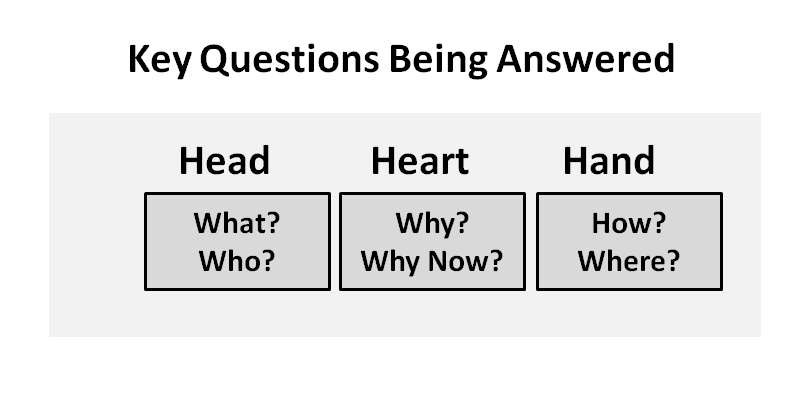 You need all three – the trifecta, but all too often executives (and consultants) only get 1 or 2 of them right. This can cause problems as described below:
You need all three – the trifecta, but all too often executives (and consultants) only get 1 or 2 of them right. This can cause problems as described below:
#1: Head, but no Heart or Hand. This is quite common. The consultants do a great job of solving the problem on paper, but don’t give enough consideration on how the client will motivate (heart) her people to take action, or specifically what the direct reports (hands) need to be doing. Lots of high-power thinking, but that is about it. The solution is too theoretical, complex, or radical. I have heard executives joke that consulting recommendations that were “shelf-ware”because it was so impractical that it went right on the shelf, as if it was a textbook.
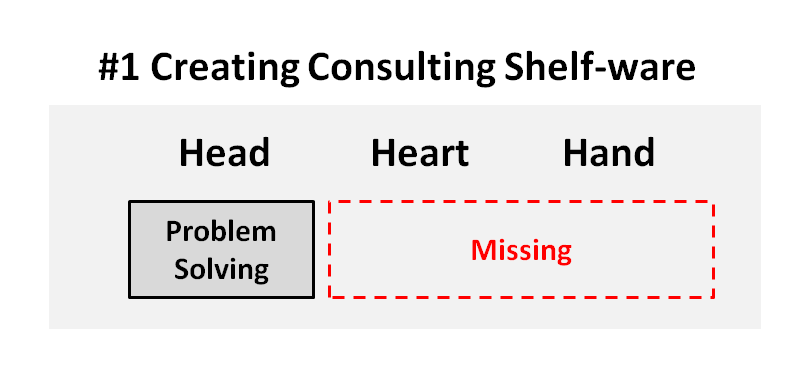 In the consultant’s defense, many clients only want the problem solving (head) and expect their internal teams to pick it up from there; they don’t want to pay consultant hourly rates for what they consider the tactical details. Knowing this, consultants often propose an optional “phase 2” of the project for the change management, risk assessments, project planning, process mapping, tool creation and other general “hand-holding”.
In the consultant’s defense, many clients only want the problem solving (head) and expect their internal teams to pick it up from there; they don’t want to pay consultant hourly rates for what they consider the tactical details. Knowing this, consultants often propose an optional “phase 2” of the project for the change management, risk assessments, project planning, process mapping, tool creation and other general “hand-holding”.
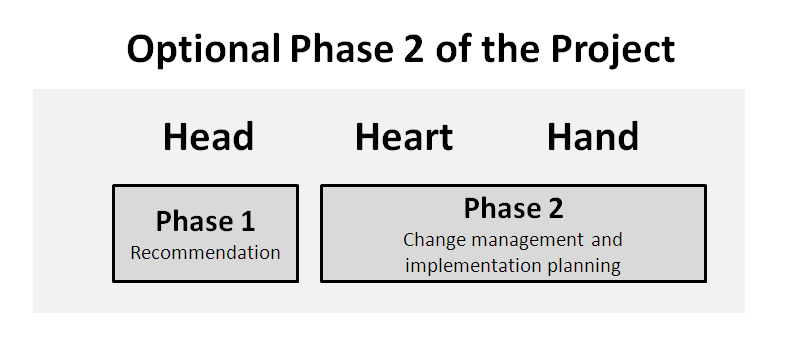 #2 Hand, but No Head, No Heart. Sometimes a client will call you for something very tactical – perhaps writing a Standard Operating Procedure (SOP), or creating some training materials – that can be handled quickly and cheaply. Unsurprisingly, the results are also limited and muted.
#2 Hand, but No Head, No Heart. Sometimes a client will call you for something very tactical – perhaps writing a Standard Operating Procedure (SOP), or creating some training materials – that can be handled quickly and cheaply. Unsurprisingly, the results are also limited and muted.
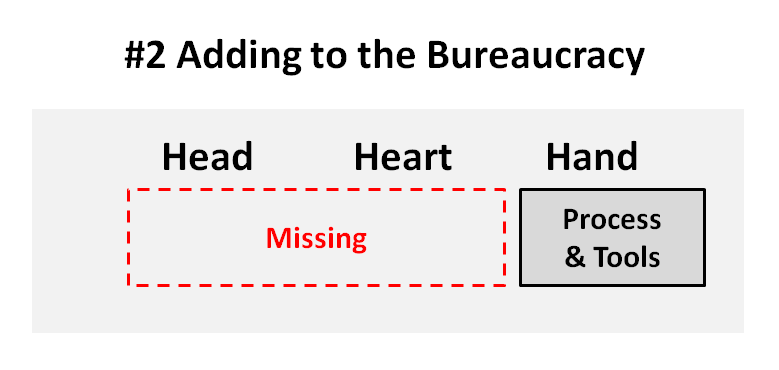 A cynic might say that that US government has this problem. Lots of rules, process, guidelines without an overarching strategy of WHAT we are doing or consensus of WHY we are doing it. An example of this might be the Frank Dodd amendment which is 848 pages long (download here, if you are brave) compared to the original, more impactful Glass-Steagall Act of 1933 (download here, only 38 pages, but just as boring) that separated commercial and investment banking. US tax code = 9,000+ pages, same issue.
A cynic might say that that US government has this problem. Lots of rules, process, guidelines without an overarching strategy of WHAT we are doing or consensus of WHY we are doing it. An example of this might be the Frank Dodd amendment which is 848 pages long (download here, if you are brave) compared to the original, more impactful Glass-Steagall Act of 1933 (download here, only 38 pages, but just as boring) that separated commercial and investment banking. US tax code = 9,000+ pages, same issue.
#3 Heart, but No Head, No Hand. Executives (CEO, COO, CEO etc) sometimes develop pet projects, especially ones that are related to leaving a legacy, that don’t always pass muster. This is probably one of the main reasons that 2/3 of mergers tend to fail (the destroy economic value).
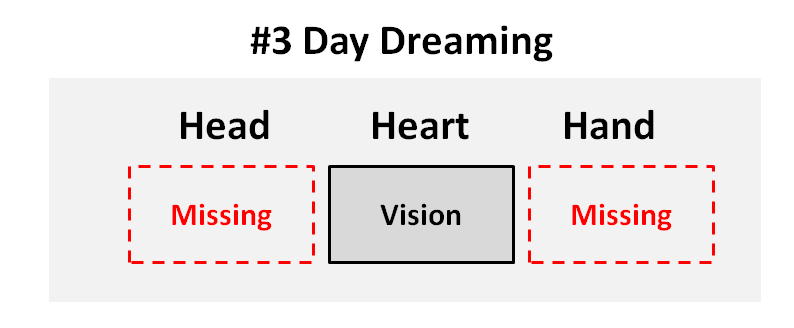 Ineffective Change. I think you get the idea. You need all three elements for change to really take root. If you only have 2 of the 3, you might reach the goal-line, but it will be slower and more painful. Can you imagine:
Ineffective Change. I think you get the idea. You need all three elements for change to really take root. If you only have 2 of the 3, you might reach the goal-line, but it will be slower and more painful. Can you imagine:
- Scenario #4: Reckless enthusiasm because there is a lots of vision, passion, and activity, but not much of a plan. Ouch.
- Scenario #5: Strategy without legs because there is a reasonably well thought-out plan and vision, but nothing is happening. The troops don’t know what to do.
- Scenario #6: Disjointed action because there is a strategic plan and roadmap. We all know what needs to be done, but frankly, none of us know why we are doing it – other than our bosses told us to do it.
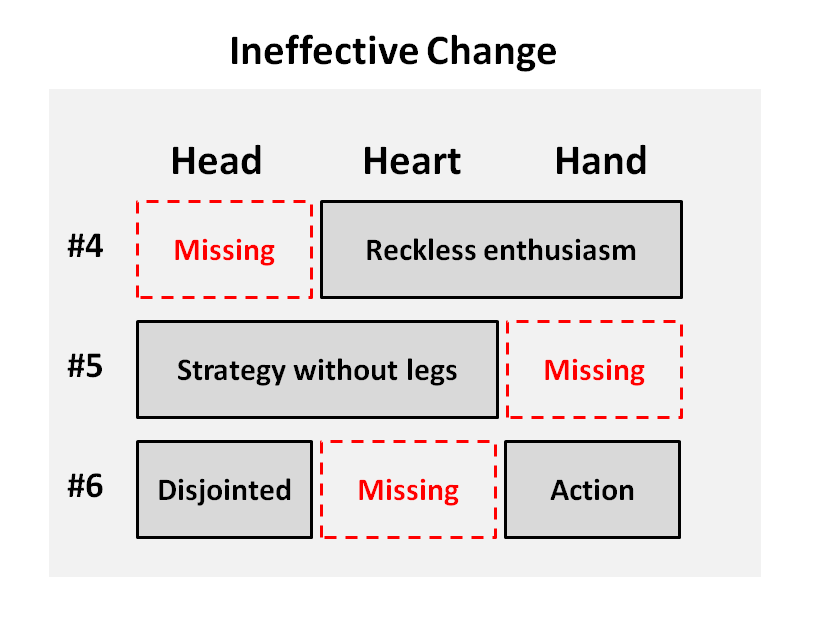 Creating effective change is an art. Good management consultants know how to piece together the head, heart and the hand. It can be complicated and often takes time because culture does not change over-night. We also need to remember that most people in the organization know very little about our projects. They will be the last to hear about it, and it is usually only by email or some other generic announcement. Complex problems require thinking, feeling and doing.
Creating effective change is an art. Good management consultants know how to piece together the head, heart and the hand. It can be complicated and often takes time because culture does not change over-night. We also need to remember that most people in the organization know very little about our projects. They will be the last to hear about it, and it is usually only by email or some other generic announcement. Complex problems require thinking, feeling and doing.
“For every complex problem there is an answer that is clear, simple, and wrong.” – H.L. Menken
Related Posts:

Hi, great article but it leaves me with the doubt about how to succesfully appeal to the heart. Most scenarios i’ve seen are like #6, a well thought plan and a well designed tool but no means to motivate the team. I would really appreciate if you could point me in the best way to address this.
Thank you.
Yes, great question. For me, I think that is where leadership comes in. That is something that outsiders cannot provide. That’s up to the client leadership to make happen. What are your thoughts?
It is as you say, the leadership has the main role in the motivation, but as a developer and consultant i think that at least we can contribute with the motivation through the ease of use of the tool. In the scenario #2, the dread provoked by the bureaucracy is partially fault of the unresponsiveness of the tools.
Completely agree with all of that. There are many subtle things we can do while a consultant to 1) build relational equity 2) make it easy for the client to follow 3) empower our client counterpart to make it THEIR STORY 4) use lots of data and logic to make it a clear conclusion etc. . .
Our success record can be tracked in many ways . . . including the # of implementations we encourage / start / motivate / or get going. . .
Consultants seek to create the ‘money slide’ that is so compelling that the client CEO prints it out and waves it like a bloody flag at every meeting with his troops (head inspiring heart).
Would love to hear other ‘heart’ examples.
So true. So true.
thanks for sharing the blog
Nice to read-out your valuable method in which you explain the sophisticated management approach! Thanks for sharing.
For IT project managers I found this article helpful too: Best Practices for IT Project Managers
Engaging the Heart, enlightening the Head, and equipping the Hands to lead successful and sustainable change is precisely what Change Intelligent® people, teams and organizations do. I invite you to learn more, including how to diagnose and develop your own CQ®, by exploring the resources at http://www.ChangeCatalysts.com. Enjoy – and let’s continue the conversation!
Agreed – Head, Heart, Hand. It’s simple and effective.